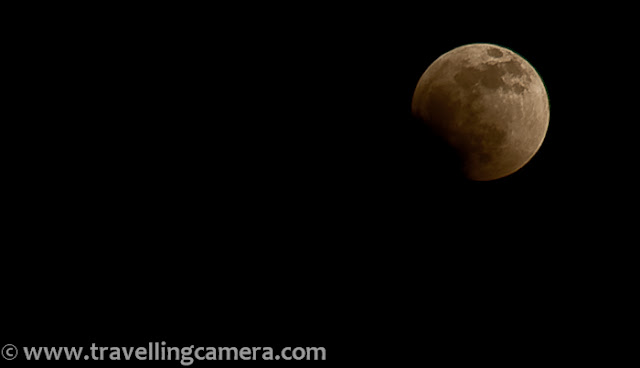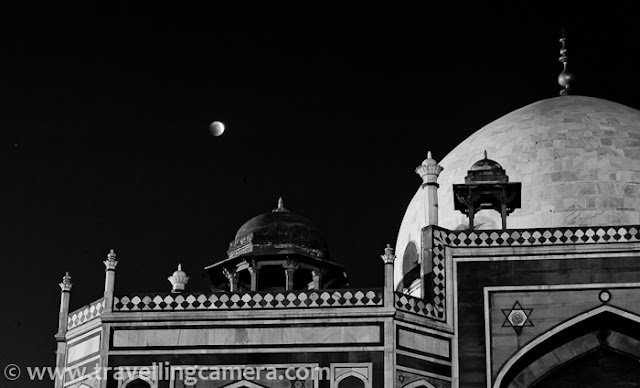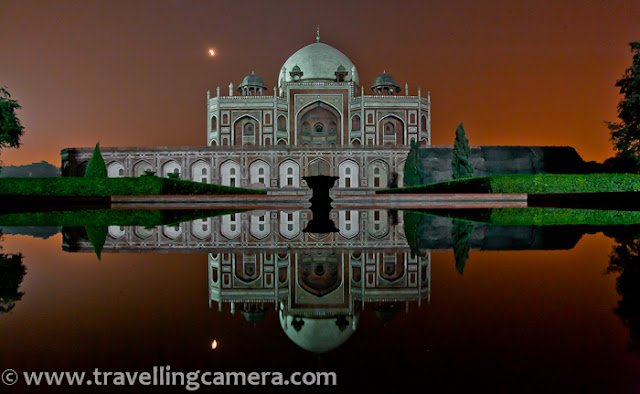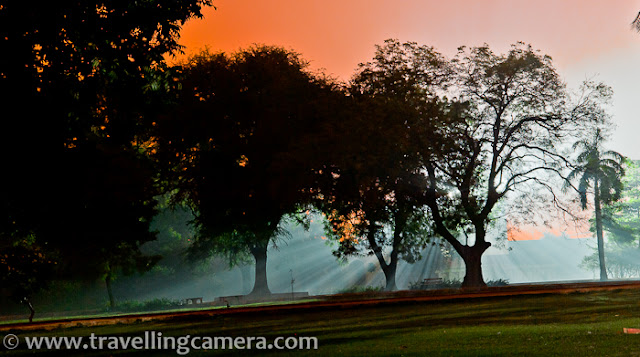Humayun's Tomb - Taj Mahal of Delhi in shining Red stone and a popular UNESCO World Heritage site in Indian capital
Taj Mahal of Delhi in red stone is Humayun's tomb, although the real connection between Taj Mahal & Humayun's tomb is more interesting. When Taj Mahal was built, the inspiration for Architecture came from this beautiful tomb in Delhi. Certainly the size of Taj Mahal is huge in comparison to the Humayun's Tomb and other basic difference is kind of stone used. Taj Mahal is made up of white marble when Humayun's tomb is in Red Stone. Both of these beautiful monuments are symmetrical and built on top of a square platform. Look at the monument from any of the four directions and it will look the same.
Humayun Tomb is one of the popular place among Delhi Photographers and many of the Photographers have worked on this beautiful monument. I have visited this place many times and this time we were accompanying some of the office folks who had come from US and wanted to explore something around Delhi.
How to reach Humayun's Tomb in Delhi?
Nearest Metro station to Humayun Tomb :
Nearest metro station is Jor Bagh station which comes on the yellow line of metro railways from where it would be easy to reach Humayun's Tomb by taking an auto or a taxi.
One can get down at Jawahar Lal Nehru stadium lying over the purple line of metro railways. It is very simple to reach from here, as well.
Delhi Tourism HoHo bus - HOHO buses run by Delhi Tourism stops at Humayun's tomb. If you are in city for a day or 2, this is recommended option because Hoho buses run between some of the most popular tourist places and convenient.
App based taxis like Uber/Ola
Auto-Rickshaw or Cycle-Rickshaw
Nearest metro station is Jor Bagh station which comes on the yellow line of metro railways from where it would be easy to reach Humayun's Tomb by taking an auto or a taxi.
One can get down at Jawahar Lal Nehru stadium lying over the purple line of metro railways. It is very simple to reach from here, as well.
Delhi Tourism HoHo bus - HOHO buses run by Delhi Tourism stops at Humayun's tomb. If you are in city for a day or 2, this is recommended option because Hoho buses run between some of the most popular tourist places and convenient.
App based taxis like Uber/Ola
Auto-Rickshaw or Cycle-Rickshaw
Humayun Tomb Timings: All monuments in Delhi open around sunrise and close by sunset. That timing is applicable to Humayun's tomb as well.
Humayun Tomb Tickets:
During day time, entry fees for SAARC citizens is 10 Rs. SAARC includes Bangladesh, Nepal, Bhutan, Sri Lanka, Pakistan, Maldives and Afghanistan...
BIMSTEC Countries like Bangladesh, Nepal, Bhutan, Sri Lanka, Thailand and Myanmar also need to pay 10 Rs only. For others it's $5.
Here is one of the simple shot took around Humayun Tomb, when eclipse just started. This shot was taken around 6:35 pm on 10th Dec, 2011. It was part of a project we did around various monuments of Delhi. Usually Lunar Eclipse used to take place in January, when sky is mainly covered with clouds or fog. Since this time, it happened early, people got to see it clearly and there was huge buzz among various Photography communities. I was lucky to get access to these heritage sites in Delhi on the evening of lunar eclipse.
Here are some water ponds in all four directions of Humayn's Tomb, but the one in front of entry gate is maintained well. Reflection of the main tomb was looking awesome in Eclipse hours, although above photograph failed to show the real magic... You can see the shining moon in the sky and lovely hues of sunset, when exposed this view for a long time.
A similar photograph of Humayn Tomb, with some part of it being reflecting on adjoining water stream. Usually Humayun Tomb closes before Sunset, but if someone wants to have access for some specific purpose, permissions are required in advance.
Humayun's Tomb is a tomb of the Mughal Emperor Humayun, which was commissioned by Humayun's wife Hamida Banu. It was the first garden-tomb on the Indian subcontinent and is located around Nizamuddin East, Delhi, India. It was also the first structure to use red sandstone at such a scale.
Humayun's Tomb is a huge area having multiple Mughal architectural forms in this huge campus. It is located in East-Nizamuddin area of Delhi, India. This area has main tomb of the Emperor Humayun as well as numerous others. The complex is a World Heritage Site and the first example of this type of Mughal architecture in India.
Opposite side of Humayun Tomb, Delhi, INDIA
Humayun's tomb is not as touristy as other place in Delhi like Red Fort, Qutub Minar, India Gate etc.
Humayun’s Tomb is in close to Sarai Kale Khan and in order to get there, it is best to use the Delhi metro-rail. The metros also have air conditioning, but be aware that metro trains are crowded most of the times.
Humayun Tomb is very well maintained by Archaeological Survey of India !!! ASI is is the organization to get special permissions to get entry into Humayun Tomb in odd hours. There is lot of green area around main tomb in this campus. And there is very special thing about Mughal Architecture that all four areas around a building are maintained in similar fashion. Alignments of landscapes, gardens and trees would be exactly same.
Humayun's Tomb is frequently visited by visitors from foreign countries as well as from India itself too. There are many photography walks organized all around the year since the tomb itself and the three beautiful gardens surrounding the tomb are worth capturing with your Travellingcamera. Morning is the best time to visit Humayun's Tomb because of various reasons.
This photograph would be giving you a sense about it's shape and architecture. It has a square base and all four faces of Humayun Tomb look same. Theoretically it's a two storey building but height of one storey is unmatchable :) ... Whole building is made of red stone and Taj Mahal is exactly replica of this building, but in white marble.
Light streaks touching ground after filtering through tree leaves around Humayun Tomb. Such photographs from early morning look stunning, as light is most favourable at that point of time of the day.
Humayun Tomb is also in the list of World Heritage sites maintained by UNESCO. Check out http://whc.unesco.org/en/list/232 for more details.
Every other site about Delhi has special mention of Humayun Tomb, so I would not repeat all those well known facts about the place.

Barber's Tomb in Humayun's Tomb compound :
Inside Char Bagh of Humayun's tomb compound, there is this tomb called Nai-ka-Gumbad or Barber's Tomb. This one belongs to royal barber. Few years ago this part of the campus was renovated by archeological survey of India. Its proximity to the main tomb and the fact that it is the only other structure within the main tomb complex suggests its importance.
Close to the Barber's tomb, there are some ruins which certainly need lot of efforts in terms of maintaining them well.
Main Tomb as reflection in a small water pond in front of Humayun's Tomb. Actually there are four such ponds facing all four doors of the tomb but the other three are not as maintained as the one in front of main gate is. Water Fountains are also installed in these ponds, which are creating these ripples in water.
Humayun's Tomb is a two storey building, but each storey of this building is extremely huge. Above Photograph shows first storey of this building and see the difference between height of a man and this huge building. Every part of these buildings is huge including staircases.
Humayun's tomb was declared a UNESCO World Heritage Site in 1993 and since then has undergone extensive restoration work. Besides the main tomb enclosure of Humayun, several smaller monuments.
Birds flying around the second gate of Humayun's Tomb (A Sunset Shot)
Lot of tourists visit this place and try to understand the Mughal Architecture.
A Pigeon sitting on one of the window and photograph is shot from inside the main Tomb. During Sunset, some wonderful shades of light can be seen peeping inside the Humayun's tomb.
This photograph was clicked during sunset time. There are some beautiful jaidaar windows at Humayun's tomb and light through them create some beautiful light-effects. Above photograph shows one of the those light-plays inside the tomb.
Islamic rule in India also introduced Islamic architecture into the subcontinent and early monuments started appearing in and around Delhi, the capital of Delhi Sultanate. North India was successive ruled foreign dynasties in the coming centuries giving rise to the Indo-Islamic architecture.
The combination of red sandstone and white marble was previously seen in Delhi Sultanate period tombs and mosques, most distinctively in the highly decorative Alai Darwaza in the Qutub complex.
Above Photograph shows a Jalidar Window on extreme left from where golden light rays of sunset are passing to his two walls on the right. This photograph is again shot inside the main Tomb of Humayun-Tomb Campus.
The mausoleum is a synthesis of Persian architecture and Indian traditions - the former exemplified by the arched alcoves, corridors and the high double dome, and the latter by the kiosks, which give it a pyramidal outline from distance. Although Sikandar Lodi's tomb was the first garden-tomb to be built in India, it is Humayun's tomb which set up a new vogue, the crowning achievement of which is the Taj at Agra. There is also a somewhat common human impetus behind these two edifices-one erected by a devoted wife for her husband and the other by an equally or more devoted husband for his wife.
The tomb established some of the important norms for later Mughal mausolea. It is set in a geometrically arranged garden criss-crossed by numerous water channels and probably representing symbolically a paradise setting. Such typical Persian gardens had been introduced into India by Babur; later they would be found in the Red Fort in Delhi and at the Taj Mahal in Agra.
Delhi is all about Mughal architecture and the remains of this history shows the glory of Mughal Empire in India. Humayun's tomb is one of the remarkable structures of the Mughal Empire in India. The monument is surrounded my many new buildings but still the structure has the importance of its own and sill can be seen upright and bright. Just close to the monument, there is the shrine of Nizamuddin which is very sacred place.

Above photograph shows actual tomb of Humayun - the second Mughal emperor. This is placed in main structure you have been seeing in different photographs in this blogpost.

Main Tomb is surrounded by Char Bagh and this building is very symmetrical and looks same from all four directions... Even the garden in the surroundings is very symmetric.. Over the time, it has changed due to different height trees and other things... But Mughals used to maintain their areas very well !!!




































.jpg)
Comments
Thanks Shrinidhi !